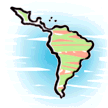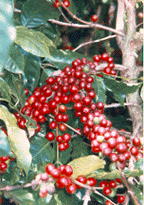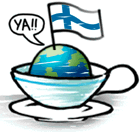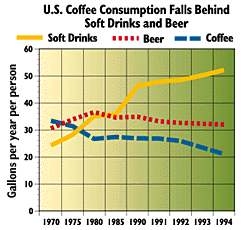COFFEE
The Story Behind Your Morning Fix
by Seth Zuckerman
 Coffee was discovered thousands of years ago by East African tribespeople
whose warriors used it to invigorate themselves for battle. Coffee has
now spread so widely across the planet that it is the second most actively
traded legal commodity in the world, exceeded only by petroleum.
Coffee was discovered thousands of years ago by East African tribespeople
whose warriors used it to invigorate themselves for battle. Coffee has
now spread so widely across the planet that it is the second most actively
traded legal commodity in the world, exceeded only by petroleum.
Coffee and its Habitat
Coffee evolved in the understory of Ethiopian highland forests, growing in the shade of taller trees. It still grows wild there; when a fungus threatened the Brazilian coffee crop in 1970, agronomists went back to coffee's native land to find resistant strains. Unlike many food crops, which are grown from hybridized seed, coffee is raised from beans right off the same bushes that produce the beans we roast and grind. Traditional coffee cultivation replicated the forest understory with which the species evolved: coffee was grown under shade provided either by native tropical forest or by fruit, firewood and timber plantings.
Although it is native only to a small corner of Africa, coffee is now grown in more than 60 countries where the climate matches the particular mix of conditions which coffee requires. The bushes need ample rainfall (from 50 to 100 inches a year) and a narrow range of temperatures, ideally between 55 and 85 degrees F and never below freezing.
 As a result, almost all of the world's coffee is grown within about
25 degrees latitude of the equator and at elevations ranging from sea level
to 6000 feet, depending on the region. About two-thirds of the world's
coffee originates in Latin America, over a quarter from Brazil alone.
As a result, almost all of the world's coffee is grown within about
25 degrees latitude of the equator and at elevations ranging from sea level
to 6000 feet, depending on the region. About two-thirds of the world's
coffee originates in Latin America, over a quarter from Brazil alone.
Beans and Bushes
 The two main species of coffee, robusta and arabica,
each have their own climatic preferences and other qualities. Robusta
flourishes on hot, low-elevation sites, mostly in Africa, and has nearly
twice as much caffeine as arabica.. Arabica, prefers altitudes
of 3000 to 6000 feet. It has a milder taste, sells for about 20 to 35%
more per green pound, and accounts for some three-quarters of the coffee
grown in the world.
The two main species of coffee, robusta and arabica,
each have their own climatic preferences and other qualities. Robusta
flourishes on hot, low-elevation sites, mostly in Africa, and has nearly
twice as much caffeine as arabica.. Arabica, prefers altitudes
of 3000 to 6000 feet. It has a milder taste, sells for about 20 to 35%
more per green pound, and accounts for some three-quarters of the coffee
grown in the world.
Mass-market coffees in the US lean heavily on the cheaper robusta beans, which is why truck-stop cups of joe taste rougher and pack a stronger kick than the brew served up in most coffee bars. Specialty coffees--upscale beans sold in bags instead of cans--are almost all arabica and account for 15 to 25% of the US market.
 A single coffee bush yields a little over a pound of beans a year,
beginning when it is three to six years old. For every cup a day you drink,
there are six bushes growing somewhere in the tropics to supply you. Each
bush is kept pruned to a height of 10 to 15 feet, with glossy, postcard-sized
leaves and showy sprays of small, cream-colored flowers. Six or seven months
later, the clusters of red coffee cherries are ready for harvest.
A single coffee bush yields a little over a pound of beans a year,
beginning when it is three to six years old. For every cup a day you drink,
there are six bushes growing somewhere in the tropics to supply you. Each
bush is kept pruned to a height of 10 to 15 feet, with glossy, postcard-sized
leaves and showy sprays of small, cream-colored flowers. Six or seven months
later, the clusters of red coffee cherries are ready for harvest.
Harvest season varies around the world. In Mexico it comes between November and January; in São Paolo, Brazil, from May to September; and in Java, Indonesia, practically year-round. The robustas and most of the Brazilian arabicas are left on the bush until all the cherries are ripe. Most of the other arabicas are harvested in several passes, picking the cherries as they ripen, to allow for the wet processing, which provides a higher quality, milder tasting coffee. In the wet process, the pulp is removed from the coffee cherries with copious quantities of water, typically winding up in local streams where its decomposition uses up oxygen required for fish and other aquatic life. Two pounds of pulp and about a gallon of water are discarded for every pound of beans.
|
|
|||
|
|||
Historically, coffee has been one of the better cash crops for small landowners in the tropics. Its price is subject to the vagaries of the world market, but coffee yields more income per acre than corn or beef and requires little cash investment to establish. It is estimated that some 20 million people worldwide are involved in growing the bean.
Until the 1970s, most coffee was grown in shaded plantations, which also provided farmers with timber, firewood and fruits such as citrus, guavas, and avocadoes. In El Salvador, where 95% of the original forest has been converted to other uses, prunings from the shade overstory are a significant source of cooking fuel. Many of the shade trees are nitrogen fixers, which enrich the soil and reduce the need for chemical fertilizers. This traditional mixed-tree method sets coffee apart from other cash crops such as sugar cane and bananas, in which whole fields are covered by just one plant species.
Coffee, Birds, and Other Species
Traditional shade coffee plantations accommodate a variety of wild species. This characteristic is particularly important in some Latin American countries, where coffee plantations constitute as much as 60% of the remaining woodlands. Biologists led by Russell Greenberg from the Smithsonian Migratory Bird Center censused the birds on shade coffee plantations in the Mexican state of Chiapas, and counted up to 150 species per tract of 12 acres or less. Greenberg and his colleagues found that the bird populations in shade coffee plantations were about as diverse as in nearby native rainforests, and much more diverse than on other cultivated land. Many of the species encountered were songbirds that spend summers in Canada and the United States.
 Another researcher, the US Forest Service's Joseph Wunderle, studied
the "overwintering site persistence" of songbirds in shaded coffee
plantations in the Dominican Republic. He found that 68 to 77% of the birds
he sighted in October were still on the same tract in January--a comparable
figure to what is found in natural forests. The avian implications are
so significant that the Smithsonian Migratory Bird Center convened a Sustainable
Coffee Congress last September; the center also published fact
sheet on the benefits of shade coffee.
Another researcher, the US Forest Service's Joseph Wunderle, studied
the "overwintering site persistence" of songbirds in shaded coffee
plantations in the Dominican Republic. He found that 68 to 77% of the birds
he sighted in October were still on the same tract in January--a comparable
figure to what is found in natural forests. The avian implications are
so significant that the Smithsonian Migratory Bird Center convened a Sustainable
Coffee Congress last September; the center also published fact
sheet on the benefits of shade coffee.
Shade-coffee plantations also shelter a broad range of terrestrial life-forms, from howler monkeys to fully half as many species of snakes as in native forests. Research in Costa Rica showed that hundreds of species of beetles and dozens of varieties of ants inhabited each tree shading the coffee bushes. In Puerto Rico, when agricultural fields have gone out of production, shade-coffee plantations have provided the nuclei from which the rainforest recolonized the abandoned land. There's also evidence that rare species of orchids have persisted on Puerto Rican shade-coffee plantations when they would otherwise have gone extinct.
"Technification"
Over the last twenty years, a new development has encroached on traditional coffee growing: "technification." This transformation involves replacing the traditional multi-story cultivation arrangement with a monoculture. New kinds of coffee bushes are planted, bred to tolerate solar exposure and administered regular doses of chemical fertilizers, herbicides and pesticides. This sun coffee is also planted much denser than shade coffee: 1200 to 3000 bushes per acre, compared with 400 to 800, according the the Natural Resources Defense Council.
The original impetus to technify came from fear of coffee leaf rust, which appeared in Brazil in 1970 and broke out in Nicaragua in 1976. Agronomists predicted that stripping away the shade trees would keep the coffee plants too dry to support the fungus. Technification also promised higher yields, which have come to pass: 1400 pounds per acre in the sun versus 500 in the shade, according to a recent article in Science.
So far, 2.7 million acres in northern Latin America--about 40% of the total--have been converted to full-sun cultivation. In Colombia, the most technified country in the region, the process has swept some 70% of the coffee plantations. International aid groups have expedited the trend. The US Agency for International Development, for instance, has spent $80 million in the last two decades to promote technification.
Technified coffee costs more to grow, because of the extra chemicals and labor involved. Even with the higher yields, the production costs in one Nicaraguan study were 56 cents per pound for technified coffee versus 39 cents for traditional shade coffee. When the world price of coffee is high, the elevated yields of sun coffee pay off. When the price hovers in the 60s and 70s, as it did through 1993, technified coffee growers see their profit margins evaporate. (For comparison, the price this month has been between $1.25 and $1.80 per pound, depending on the quality and the date of delivery.) Current quotes are available at the Coffee, Sugar & Cocoa Exchange, Inc. As it turns out, most coffee-growing regions in Latin America are inhospitable to the leaf rust after all, apparently because of the cool temperatures and long dry seasons.
|
|
|||
|
|||
Environmental Effects of Technification
The loss of shade cover has diminished the value of coffee plantations to other species. Studies in Colombia and Mexico found 94% fewer bird species in sun-grown coffee plantations than in the traditional shade-grown ones. In Guatemala, the Smithsonian's Greenberg found that sun coffee harbored half the density and diversity of birds as shade coffee. And researchers are growing increasingly certain that coffee technification is to blame for the decline of some songbirds. The Baltimore oriole winters in Latin American shade-coffee plantations; its numbers dropped significantly between 1980 and 1994, when technification was at its height. The rest of the oriole's habitat was holding steady, and its losses apparently can only be explained by the disappearance of its winter habitat on the coffee farms.
 Coffee is the third most heavily sprayed crop in the world, behind
cotton and tobacco, and pesticide use is highest on technified plantations.
Many insecticides banned in the US continue to be used on coffee, including
endosulfan, carbaryl and chlordane. Most of the consequences are borne
by the growers and their neighbors. For example, more than 200 poisonings
and four deaths were attributed to endosulfan use on coffee in Colombia,
according to official records assembled by Pesticide Action Network North
America. Pesticide residues pose no problem for coffee drinkers, since
the chemicals tend to be driven off in the roasting process.
Coffee is the third most heavily sprayed crop in the world, behind
cotton and tobacco, and pesticide use is highest on technified plantations.
Many insecticides banned in the US continue to be used on coffee, including
endosulfan, carbaryl and chlordane. Most of the consequences are borne
by the growers and their neighbors. For example, more than 200 poisonings
and four deaths were attributed to endosulfan use on coffee in Colombia,
according to official records assembled by Pesticide Action Network North
America. Pesticide residues pose no problem for coffee drinkers, since
the chemicals tend to be driven off in the roasting process.
What's an ecology-minded coffee drinker to do? There are three initiatives to give coffee drinkers the information to judge their java.
Organic Coffee
Organic coffee is grown without the use of synthetic chemical fertilizers, pesticides or herbicides. It now holds about 1 to 2% of the worldwide market in specialty coffee, and about 0.5% of the total US market. Several outfits now certify growers as organic, including the Nebraska-based Organic Crop Improvement Association. It is estimated that 60 to 70% of organic coffee is shade grown.
Yields average about 25 to 40% lower than conventional farms. Nonetheless, growers have committed more than 200,000 acres to the OCIA program in Peru, Mexico, Guatemala, El Salvador, Nicaragua and Costa Rica. Other certifiers (such as Australia's NASAA and the Netherlands SKAL) vouch for coffee from Papua New Guinea, Colombia, Indonesia and beyond.
Growers turn out to be more reluctant to give up chemical fertilizers than pesticides, given the difficulty of finding enough compostables in the developing world. Another barrier is the cost of certification, which can be overcome when growers band together in marketing cooperatives. One example is ISMAM, consisting of 1200 farmers in the Mexican state of Chiapas, who export 1300 tons a year to the United States, Europe and Japan.
Cost and taste are comparable to other specialty coffees, according to a review in this spring's edition of Coffee Journal. The average price of the 15 organic coffees they tasted was just 3 percent higher than the coffees they reviewed in their previous issue; most were between $8 and $10 per pound. Reviewers lauded the Papua New Guinea coffees, found the Sumatran somewhat wanting compared with uncertified coffee from the same region, and praised the Latin American submissions. They also wondered whether the roasting might be responsible for more faults in the coffee than the growing.
Eco-coffee
While organic coffee emphasizes growers' abstaining from synthetic chemicals and building healthy soil, "eco-coffee" focuses on the environmental effects of different coffee-growing systems, such as shade versus sun, dumping of pulp into streams, and soil erosion. The Rainforest Alliance and its Latin American partners launched the Eco-O.K. trademark five years ago to distinguish products that are grown with concern for the larger landscape.
Originally applied to bananas, the first Eco-O.K. certification for coffee was awarded last year to a 1000-acre plantation in Guatemala. Three other certifications, in Guatemala and Costa Rica, are under consideration. The Rainforest Alliance explains that farmers need to be allowed to use pesticides occasionally to prevent complete loss of their crop. However, the 12 most toxic pesticides are prohibited on Eco-O.K. plantations, and other chemical use is minimized.
Fair Coffee
A large fraction of the world's coffee is grown on small- to medium-sized plantations. In Colombia, for instance, 26% of the crop comes from farms under 20 acres; and about half from farms that cover between 20 and 125 acres.
The campesinos who raise that coffee are far from their crop's ultimate markets, and are insulated from their consumers by several layers of middlemen, often referred to in Latin America as "coyotes." As a result, most growers receive only about 5 to 10% of the retail price of coffee.
 In a day's work, a coffee picker can harvest enough cherries to make
30 to 50 pounds of beans. If pickers earned five dollars an hour, their
wages alone - not counting the cost of cultivation, processing, and transportation
- would exceed the world price of green coffee.
In a day's work, a coffee picker can harvest enough cherries to make
30 to 50 pounds of beans. If pickers earned five dollars an hour, their
wages alone - not counting the cost of cultivation, processing, and transportation
- would exceed the world price of green coffee.
In the last decade and a half, a "fair trade" or "alternative trade" market has arisen to ensure that growers receive a fair deal. Farmers band together in cooperatives to sell their coffee directly to importers at a higher price than they would receive from a middleman. Many of these arrangements guarantee growers a minimum price, regardless of the volatile world market, and offer low-interest credit and technical training to farmers.
Aztec Harvests, used in Ben & Jerry's ice cream, is the product of one such venture, and is marketed in the US by a community-organizer-turned-coffee-roaster who uses the slogan, "not just a cup, but a just cup." Other "fair coffee" trademarks include Transfair, Max Havelaar and Equal Exchange, and have garnered as much as 5% of the market in some European countries.
Sources for More Information
The story of a coffee grower in a cooperative marketed by Aztec Harvests is told in Leah Hager Cohen's impressive new book, Glass, Paper, Beans: Rrevelations on the Nature and Value of Everyday Things. Cohen recounts the origin of her newspaper, cup of coffee and the glass it is served in. Strung through the book is a slice of the life of Basilio Salinas, a farmer in Oaxaca, Mexico, and his daily travails and joys. A lyrical insight into what it really takes to bring coffee to the western world.
For access to coffee resources on the Web, try Over the Coffee -- great referrals to brewing and home-roasting tips, coffee books, 'zines and poetry, vendors, and coffee conferencing.
The quarterly magazine of gourmet coffee, Coffee Journal, has a site on the Web displaying the contents of the current issue.
Northwest Environment Watch has probed the implications of many of the everyday objects we consume, from coffee to computers, shoes to t-shirts. Their findings are sumarized in a slim volume, Stuff: The Secret Lives of Everyday Things, available for $9.95.
For more details about the environmental implications of coffee growing, try Coffee, Conservation and Commerce in the Western Hemisphere, a booklet published by the Natural Resources Defense Council and the Smithsonian Migratory Bird Center. $10 from the SMBC, National Zoological Park, Washington, DC 20008. Some of the material can be found on the Web.


